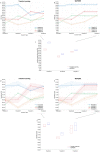Leveraging clinical data across healthcare institutions for continual learning of predictive risk models
- PMID: 35590018
- PMCID: PMC9117839
- DOI: 10.1038/s41598-022-12497-7
Leveraging clinical data across healthcare institutions for continual learning of predictive risk models
Abstract
The inherent flexibility of machine learning-based clinical predictive models to learn from episodes of patient care at a new institution (site-specific training) comes at the cost of performance degradation when applied to external patient cohorts. To exploit the full potential of cross-institutional clinical big data, machine learning systems must gain the ability to transfer their knowledge across institutional boundaries and learn from new episodes of patient care without forgetting previously learned patterns. In this work, we developed a privacy-preserving learning algorithm named WUPERR (Weight Uncertainty Propagation and Episodic Representation Replay) and validated the algorithm in the context of early prediction of sepsis using data from over 104,000 patients across four distinct healthcare systems. We tested the hypothesis, that the proposed continual learning algorithm can maintain higher predictive performance than competing methods on previous cohorts once it has been trained on a new patient cohort. In the sepsis prediction task, after incremental training of a deep learning model across four hospital systems (namely hospitals H-A, H-B, H-C, and H-D), WUPERR maintained the highest positive predictive value across the first three hospitals compared to a baseline transfer learning approach (H-A: 39.27% vs. 31.27%, H-B: 25.34% vs. 22.34%, H-C: 30.33% vs. 28.33%). The proposed approach has the potential to construct more generalizable models that can learn from cross-institutional clinical big data in a privacy-preserving manner.
© 2022. The Author(s).
Conflict of interest statement
The authors declare no competing interests.
Figures



Similar articles
-
Review learning: Real world validation of privacy preserving continual learning across medical institutions.Comput Biol Med. 2025 Jun;192(Pt B):110239. doi: 10.1016/j.compbiomed.2025.110239. Epub 2025 May 8. Comput Biol Med. 2025. PMID: 40339524
-
Privacy-preserving continual learning methods for medical image classification: a comparative analysis.Front Med (Lausanne). 2023 Aug 14;10:1227515. doi: 10.3389/fmed.2023.1227515. eCollection 2023. Front Med (Lausanne). 2023. PMID: 37644987 Free PMC article.
-
Gestational weight gain prediction using privacy preserving federated learning.Annu Int Conf IEEE Eng Med Biol Soc. 2021 Nov;2021:2170-2174. doi: 10.1109/EMBC46164.2021.9630505. Annu Int Conf IEEE Eng Med Biol Soc. 2021. PMID: 34891718
-
Framework for Integrating Equity Into Machine Learning Models: A Case Study.Chest. 2022 Jun;161(6):1621-1627. doi: 10.1016/j.chest.2022.02.001. Epub 2022 Feb 7. Chest. 2022. PMID: 35143823 Free PMC article. Review.
-
Making the Improbable Possible: Generalizing Models Designed for a Syndrome-Based, Heterogeneous Patient Landscape.Crit Care Clin. 2023 Oct;39(4):751-768. doi: 10.1016/j.ccc.2023.02.003. Epub 2023 Apr 26. Crit Care Clin. 2023. PMID: 37704338 Free PMC article. Review.
Cited by
-
Predicting Hospital Readmission among Patients with Sepsis Using Clinical and Wearable Data.Annu Int Conf IEEE Eng Med Biol Soc. 2023 Jul;2023:1-4. doi: 10.1109/EMBC40787.2023.10341165. Annu Int Conf IEEE Eng Med Biol Soc. 2023. PMID: 38083775 Free PMC article.
-
Learning across diverse biomedical data modalities and cohorts: Challenges and opportunities for innovation.Patterns (N Y). 2024 Jan 17;5(2):100913. doi: 10.1016/j.patter.2023.100913. eCollection 2024 Feb 9. Patterns (N Y). 2024. PMID: 38370129 Free PMC article. Review.
-
Can we predict the future of respiratory failure prediction?Crit Care. 2025 Jun 19;29(1):253. doi: 10.1186/s13054-025-05484-7. Crit Care. 2025. PMID: 40537867 Free PMC article. Review.
-
Continually-Adaptive Representation Learning Framework for Time-Sensitive Healthcare Applications.Proc ACM Int Conf Inf Knowl Manag. 2023;2023:4538-4544. doi: 10.1145/3583780.3615464. Epub 2023 Oct 21. Proc ACM Int Conf Inf Knowl Manag. 2023. PMID: 40110564 Free PMC article.
-
Continual learning across population cohorts with distribution shift: insights from multi-cohort metabolic syndrome identification.J Am Med Inform Assoc. 2025 Aug 1;32(8):1310-1319. doi: 10.1093/jamia/ocaf070. J Am Med Inform Assoc. 2025. PMID: 40498469 Free PMC article.
References
Publication types
MeSH terms
Grants and funding
LinkOut - more resources
Full Text Sources
Medical
Research Materials

